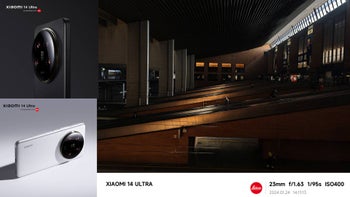Xiaomi 14 Ultra camera samples emerge as Xiaomi and Leica announce Leica Optical Institute

If you’re eager to find out what the upcoming Xiaomi 14 Ultra is capable of in terms of photography, look no further: there’s a juicy gallery with photo samples to inspect, gaze and marvel at.
The camera-centric flagship is set for a global debut on February 25 at the MWC (the maxed-out phone is expected to launch domestically in China a few days earlier), but technical details about the device have been leaking for weeks if not months.
Thanks to snoopy tipsters, we got to know the Xiaomi 14 Ultra is about to bring a 6.73-inch QHD+ AMOLED LTPO display with a 120Hz refresh rate and a large 5,300 mAh battery with 90W wired charging support. Under the hood, the state-of-the-art Qualcomm Snapdragon 8 Gen 3 chipset is expected to be found and the cameras should be something pretty special: the quad-camera setup will most likely consist of a 50-megapixel 1-inch sensor, a 50-megapixel ultra-wide, a 50-megapixel 3.2x telephoto, and another 50-megapixel 5x telephoto camera.
So, without further ado, here’s the Xiaomi 14 Ultra gallery that was posted on Weibo (and was spotted by 9to5Google):
To recap, here are the expected cameras – sensors, lenses and apertures – on the Xiaomi 14 Ultra:
Compared to the quad-camera setup on the back of the photo monster that is the Oppo Find X7 Ultra, the Xiaomi 14 Ultra is not lagging behind.
Meanwhile, Xiaomi CEO Lei Jun announced on Twitter that Xiaomi and Leica are further collaborating – he announced the “Xiaomi x Leica Optical Institute”, that’s “dedicated to building an advanced mobile imaging optical system through four key areas”:
Also, there’s an official announcement on the Xiaomi website that reads:
The camera-centric flagship is set for a global debut on February 25 at the MWC (the maxed-out phone is expected to launch domestically in China a few days earlier), but technical details about the device have been leaking for weeks if not months.
The main sensor could be none other than the Sony LYT-900, the spiritual successor to the insanely popular and beloved IMX989 sensor from Sony. LYT is short for LYTIA, and that’s the new product brand of image sensors for mobile devices developed by SSS (Sony Semiconductor Solutions Corporation).
To recap, here are the expected cameras – sensors, lenses and apertures – on the Xiaomi 14 Ultra:
- LYT-900: main camera, 1-inch sensor, f/1.63 to f/4.0 (variable aperture)
- IMX858: ultra-wide, 1/2.51-inch sensor, f/1.8
- IMX858: 3.2x (75mm) optical zoom, 1/2.51-inch sensor, f/1.8
- IMX858: 5x (120mm) optical zoom, 1/2.51-inch sensor, f/2.5
Compared to the quad-camera setup on the back of the photo monster that is the Oppo Find X7 Ultra, the Xiaomi 14 Ultra is not lagging behind.
Xiaomi and Leica announce Leica Optical Institute
Meanwhile, Xiaomi CEO Lei Jun announced on Twitter that Xiaomi and Leica are further collaborating – he announced the “Xiaomi x Leica Optical Institute”, that’s “dedicated to building an advanced mobile imaging optical system through four key areas”:
Xiaomi x Leica Optical Institute is dedicated to building an advanced mobile imaging optical system through four key areas. The #Xiaomi14Ultra represents our joint development, setting a new industry standard for optical performance. pic.twitter.com/nRwxiFQ0yv
— Lei Jun (@leijun) February 19, 2024
The Xiaomi x Leica Optical Institute, building upon its initial groundwork, is collaboratively developing a groundbreaking industry standard for optical performance in mobile devices, raising the bar both in terms of technology and user experience. This initiative places a strong emphasis on philosophy, technology, and user experience. Xiaomi 14 Ultra, a new flagship in mobile imaging, will serve as the first milestone in the practical evolution of this standard and is set to deliver unparalleled optical performance in the field of mobile imaging, with a scheduled release this month.










Things that are NOT allowed: